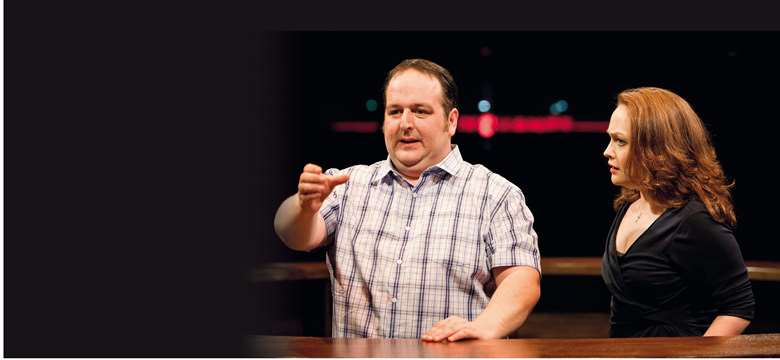Play for study: Two
Paul Bateson
Saturday, February 1, 2020
Each issue of D&T we bring you a teacher's guide to a play for study with your students, written by a fellow teacher. This issue, Paul Bateson explores the character driven Two

JONATHAN KEENAN
Jim Cartwright's Two, first performed in 1989 at the Octagon Theatre in Bolton, is a funny and touching play exploring working class characters in 1980s Northern Britain.
Although not a set text, Two can be used as a chosen performance text for GCSE. The play also works well as a piece of repertoire for BTEC Tech Award Component Two, allowing students to develop characterisation skills in workshop, and apply them in performance; while giving teachers a versatile play to cast. Studying Two in any context serves as a great exploration of characterisation and subtext at KS3, 4 and 5.
Plot
The plot is simple: a real time, one scene snapshot of life in a local pub one weekend evening. The action revolves around the landlord and landlady who run the pub, and different pairs of people who are customers. It moves back and forth, spotlighting the different relationships, coming back to the landlord and landlady each time.
Two is designed and was originally staged with only two actors playing all fourteen parts: it is literally for two people multiroling but can easily be adapted for more actors. It is particularly useful with young people where casting is often difficult and handily features roles that are male and female, young and old, comedic and serious, and though originally set in ‘a Northern town’, accents can vary without taking anything away from the stories.
So essentially Two is a series of duologues but the title also hints towards its most prominent theme: the two sides to a character. Most of these people are hiding something, longing for something or fighting something unseen to everyone else.
Exploring character
Character exploration is key when studying Two. The people in the pub at first look quite stereotypical; the odd couple watching TV and eating crisps, the new lovers out on a date, the quiet married couple, and the jovial publicans; so workshopping around physicality and voice is crucial. Discuss the advantages and disadvantages of stock characters. Read the scenes and describe the characters with adjectives. Create images or photo galleries of stereotypical people in pubs; then non-stereotypical.
After reading the scenes, discuss the subtle subtext and complex undertones. Work on mannerisms and idiosyncrasies provides depth to the characters. What might indicate Roy as a violent partner, long before he slaps Leslie in the face? What hints do the landlord and landlady give that they are suppressing their sad secret while they paint on the smiles for the punters?
In the spirit of the original, multirole exercises are fun and useful to highlight distinctions, and showcase an actor's range.
Some roles have monologues which show the characters in more detail and should be read and performed. Inventing monologues for the characters that don't have them is a really interesting activity too and gives smaller characters a voice.
Space and stage
The space is simple but can be experimented with. Do we simply stage with two stools where all the duologues occur, or do we re-create the whole pub, with numerous tables dotted around, bar, glasses, mirrors, and all? Most productions opt for economy and some study of representation and semiotics is constructive. Manchester Royal Exchange's production provides an interesting starting point.
Props could easily become messy and using a fully stocked bar with glasses could be cluttersome and distract from the stories. TVs and crisps and drinks and beer mats and ashtrays and fruit machines are all quite extraneous. Instead, focus on symbolic props and set. How can we represent the bar? Exercises on mime will help. Limit actors to one prop per character, Leslie picking a beer mat anxiously, the landlord with a cloth he both cradles and crushes in his hands throughout, Moth with his precious drink that he would lie and cheat for.
Mostly, the actors’ spatial awareness needs consideration. The challenge is giving the impression of a busy pub with only a few actors. Focus on the landlord and landlady serving imaginary customers; Mr Iger squeezing without success to reach the bar between the many drinkers; most characters referring to unseen friends and acquaintances across the room.
Social context
The pub itself has changed a lot over time, would a local pub in 2020 look like this one in 1989? Would the pub even exist? The characters are conspicuously white, and all could be considered working class. An interesting exercise would be to re-stage the play in a trendy new bar, a night club, or a hipster coffee shop. This would certainly inform design and costume in the first instance; but how might the domestic violence and controlling abuse of Roy and Leslie look in a same-sex relationship? How would Fred and Alice look as carer and dementiasufferer? The landlord and landlady as thirty-somethings?

